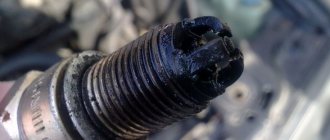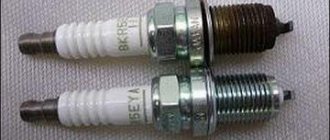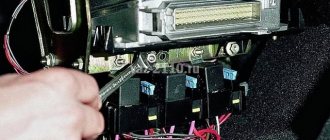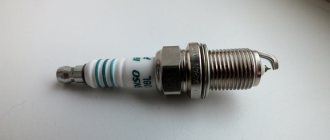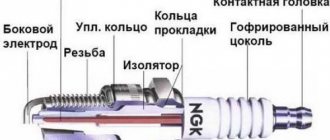When you get into a car and realize that it is impossible to start the engine, you need to find a solution to this problem. Perhaps the only thing is that the spark plugs were flooded. This problem often occurs among drivers in winter. It must be said that the cold season brings a lot of worries. As a rule, the spark plugs are filled with gasoline, but sometimes they are filled with oil.
You must first of all find out what caused this situation. In this case, you can prevent the problem of engine starting in advance. But what if such trouble has already happened? In this case, it is important to know how to get the spark plugs into working condition and start the engine.
The candles are “flooded” - what does this mean?
As we know, engine operation is ensured by three processes:
- supplying the air-fuel mixture to the cylinder;
- compression of the mixture in the cylinder when the valves are closed and the piston goes up;
- ignition of the mixture from a spark on the spark plug.
When starting the engine when cold, the problem arises at the stage of ignition of the mixture of gasoline and air. That is, the mixture enters the cylinders, but does not ignite, gasoline floods the spark plugs, and they cannot produce a spark - a vicious circle.
If the spark plugs are already wet, and the owner continues to try to start the engine, they get even more wet - and the engine will not start with such initial conditions.
Spark present
If you are familiar with the situation when there is a spark, but the spark plugs are flooded, and the crankshaft rotates well from the starter. Here it is necessary to check the spark plugs themselves, despite the fact that there is a spark. This may not mean that it will always happen under pressure. Simply put, the spark will be on the unscrewed spark plug, but it may disappear after it is installed on the power unit. What causes this? In this case, the reason for this is the increase in pressure created during operation of the internal combustion engine. The best way to determine this is through diagnostics on a special stand.
You should also pay attention to the gas distribution phases. Often their failure, various interruptions, lead to flooding of spark plugs. Injection engines can also have problems with bypass valves. Eliminating the likelihood of such problems is possible by measuring the fuel pressure in the rail. Do not forget that fuel enters the cylinders under the influence of a certain pressure. If there are deviations in any direction, flooding of the spark plugs is inevitable, which prevents the engine from starting.
Diagnostics is also important for injectors and ECM sensors directly. How does this manifest itself? It's simple, the temperature sensor, having detected a malfunction, sends incorrect data to the control unit. As a result, the ECU saturates the mixture and the fuel is poured into the injectors. Sometimes the power unit control unit itself may break down.
Why does the candles flood in winter?
The main reason why spark plugs cannot ignite the air-fuel mixture in cold weather is a weak battery . In a battery discharged by more than 40-60%, there will not be enough current to start the starter and to supply enough voltage to the spark plugs until a spark is formed. As a result, fuel is properly supplied to the cylinders, but does not ignite due to a too weak spark - and the spark plugs are flooded.
Another reason why spark plugs flood in winter is a malfunction of the ignition system itself. Either the spark plugs have exhausted their service life - and then, due to incorrect gaps, defects in the housing and electrodes, they are not able to produce a normal spark, or the high-voltage wires and their contacts are damaged. It is also worth paying attention to other elements of the system, in particular the condition of the ignition coils.
Also, the cause of the failure may be in a complex of sensors and ECU : in cold weather, the electronic control unit receives information from sensors (mass air flow sensor, lambda probe, etc.) that the injectors should supply more gasoline to enrich the mixture. And if some sensor is lying, and the control unit enriches the mixture, the injectors overfill fuel - and the spark plugs drown in excess gasoline, unable to ignite it.
Fuel of low quality or with an admixture of water due to condensation on the walls of an empty tank also prevents the mixture from igniting, while the spark on the spark plugs may be normal. Therefore, in winter it is recommended to keep the fuel tank full and switch to gasoline with a higher octane number: AI-95 instead of AI-92, for example.
In real life, it is typical when the candles flood due to a combination of all factors.
Let’s imagine a not-new engine with some wear on the CPG (compression is still normal, but no longer ideal), a battery that has become weak in the cold, thickened oil in the crankcase, tired spark plugs, a half-empty tank of gasoline. And frost in the morning.
When the owner tries to start the engine, the ECU monitors the temperature outside and the temperature of the engine, the amount of oxygen in the air that enters the intake, etc. and “understands” that it is frosty outside, and the engine needs to be started so that it does not stall - and gives the injectors a command to increase the amount of gasoline supplied - so that the enriched mixture is enough for “warm-up idle speed”.
As a result, the injectors supply fuel mixed with water into the cylinders, the starter slowly cranks the crankshaft in thickened oil from a half-dead battery, and in a cold engine with increased clearances and less-than-ideal compression, the spark plugs try to ignite the fuel due to a weak spark. The result of this scenario will be flooded candles.
Pro Tips
The following tips from professionals will help, if not completely, then at least in most cases, to prevent difficulties with starting the engine due to spark plugs filled with gasoline.
how to keep a car in good technical condition
Keeping all car components in perfect condition will help reduce the risk of unpleasant situations.
Among the main requirements, the most important ones should be highlighted:
- high-quality battery charging
- starter serviceability
- high quality oil and compliance with its parameters
- temperature outside, outside the car
- use quality spark plugs
- Maintaining high voltage wiring in perfect condition
- carry out timely cleaning and adjustment of the nozzle, and the best option should be considered
- cleaning using special equipment; It is recommended to resort to cleaning by adding special impurities to the tank only in exceptional cases, pouring only high-quality gasoline into the tank
Among the “folk” recipes we can recommend:
- After a day or two, while driving, for 10 seconds, increase the engine load to 4.5 - 5 thousand revolutions, this guarantees self-cleaning of the spark plugs from soot and cleans the chamber of existing deposits.
- In order for the engine to start reliably in cold weather and the spark plugs not to be flooded with gasoline, once a month you will need to “crank the engine”, the distance is from 50 to 100 km, at a speed of at least 100 km per hour. Use only high quality fuel.
These simple steps will help you independently monitor the condition of the car, and you will be able to save on the services of car service specialists.
Special cases
- If only one spark plug is filled with gasoline , the problem may be in a specific engine cylinder - in particular, it is worth checking its compression.
- If the starter turns, there is a spark, but the spark plugs are still flooded , a separate check of the spark plugs is needed. If a removed spark plug produces a normal spark, but cannot ignite the fuel under pressure in the combustion chamber, it makes sense to check the valve timing, the bypass valve in the fuel rail, and the serviceability of the ECM sensors.
- If the spark plugs are flooded with engine oil , it is important to determine whether this is happening from above or from below. If oil accumulates in the spark plug wells (at the top), there may be a problem with the valve cover gasket. If the spark plug is filled with oil from below, you need to check the compression in the engine, the condition of the oil rings and caps, the integrity of the cylinder head and other reasons that lead to oil leaks into the combustion chamber.
What should the owner do?
If the engine does not start the first or third time in the morning in winter, there is no need to make any more attempts. If you are sure that the cause is flooded spark plugs, you can take measures:
Method 1. Unscrew the spark plugs from the cylinder head using a spark plug wrench and dry them. Then crank the engine with the starter without spark plugs for 10 seconds, screw the spark plugs back in and try to start the engine again.
Method 2. You can use the technique of “blowing out” the spark plugs without removing them from the engine. To do this, you need to press the gas pedal all the way, and then use the starter to crank the crankshaft for about 10 seconds, then you can release the pedal. Thus, when the throttle valve is open, a lot of air enters the cylinder, which dries out the spark plugs.
Method 3. If the engine does not start after express purging, the spark plugs will have to be unscrewed and dried manually. It is not recommended to clean spark plugs with sandpaper or a brush with metal bristles: this can easily damage the protective coating and scratch the electrodes.
To carefully clean carbon deposits from candles, it is better to use mild household products for cleaning plaque and rust, in the form of a gel and a soft toothbrush or brush. The candles are placed with threads in the solution for half an hour until the coating softens, and then they are cleaned with a brush and washed in water. Dry by wiping dry with a construction or household hairdryer or on a radiator until completely dry. Some owners calcine it in the oven or on the stove. And they screw it back in.
Method 4. A better strategy would be not to clean and dry the flooded candles, but to buy new ones. Because cleaning and calcining candles reduces their resource. These parts are not that expensive and last no more than 15-25 thousand km. Of course, if new spark plugs still continue to be filled, it is necessary to carry out in-depth diagnostics of sensors and other elements of the ECM system, in particular, coils.
How to solve a problem
First, we determine the cause of the difficulties. Next, we will work out possible problem scenarios when...
Fills with gasoline
We bleed the cylinders for 10 seconds when opening the throttles. The goal is to get a lean mixture. Unscrew, clean and dry the candles. Check for gaps or other damage. We check the battery voltage with a multimeter.
Do not start the engine until the current problem has been resolved. Try this:
- After the third unsuccessful attempt, wait 10 minutes and try again.
- Be sure to charge the battery.
- Install spare spark plugs. Dry the filled parts and inspect the metal for possible damage.
- Start the engine only after the spark plugs have dried and the battery is fully charged.
Fills with oil
Can fill from above and below. When the insulator is flooded, immediately remove the grease with a syringe or paper. The problem is eliminated depending on the situation: the gasket is replaced or hermetically sealed.
With strong oil flows, it is illogical to move further. We fix the problem by replacing the seals, rings or valve guides.
It is wise to replace oil seals when the valve bushings are still in good condition. Because a new part will not change the situation. Then it is more logical to replace the guide bushings. If there is significant wear, the valves are also replaced.
Fills with antifreeze
The cause of this problem is a burnout of the cylinder head gasket and problems with the geometry of the “head”. Therefore, we replace materials and polish the surface.
In case of serious damage to the head, it is recommended to contact specialists from auto repair shops. The workshop staff will quickly restore the shape of the part. For this purpose, service technicians use professional machines.
Other reasons
In addition to the already mentioned main reason for flooding candles, there may be others:
- When starting, the crankshaft turns slowly (we are repairing the crankshaft).
- The malfunction lies in the valve stem seals, which allow oil to pass through (we change the valve stem seals).
- The injector is clogged, but continues to supply gasoline and fills the spark plugs with it (we clean the injector).
- Water appears in gasoline (this happens most often in winter, we choose the right brand of gasoline - “winter” or “summer”).
The latter case is also quite common, especially at sub-zero air temperatures. This is due to the fact that gasoline, which has low volatility, has a poor combination with cold air, so the fuel mixture becomes heterogeneous and begins to flood the spark plug elements.
